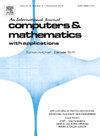A lattice-Boltzmann inspired finite volume solver for compressible flows
IF 2.5
2区 数学
Q1 MATHEMATICS, APPLIED
引用次数: 0
Abstract
The lattice Boltzmann method (LBM) for compressible flow is characterized by good numerical stability and low dissipation, while the conventional finite volume solvers have intrinsic conversation and flexibility in using unstructured meshes for complex geometries. This paper proposes a strategy to combine the advantages of the two kinds of solvers by designing a finite volume solver to mimic the LBM algorithm. It assumes an ideal LBM that can recover all desired higher-order moments. Time-discretized moment equations with second-order temporal accuracy and physically consistent dissipation terms are derived from the ideal LBM. By solving the recovered moment equations, a finite volume solver that can be applied to nonuniform meshes naturally, enabling body-fitted mass-conserving simulations, is proposed. Numerical tests show that the proposed solver can achieve good numerical stability from subsonic to hypersonic flows, and low dissipation for a long-distance entropy spot convection. For the challenging direct simulations of acoustic waves, its dissipation can be significantly reduced compared with the Lax-Wendroff solver of the same second-order spatial and temporal accuracy, while only remaining higher than that of the LBM on coarse meshes. The analysis implies that approximations of third-order temporal accuracy are required to recover the low dissipation of LBM further.
格子-玻尔兹曼启发的可压缩流有限体积求解器
晶格玻尔兹曼法求解可压缩流具有数值稳定性好、耗散小的特点,而传统的有限体积求解方法在求解复杂几何形状的非结构化网格时具有固有的可移植性和灵活性。本文通过设计一个模拟LBM算法的有限体积求解器,提出了一种结合两种求解器优点的策略。它假设一个理想的LBM可以恢复所有期望的高阶矩。从理想LBM出发,导出了具有二阶时间精度和物理一致耗散项的时间离散矩方程。通过求解恢复力矩方程,提出了一种适用于非均匀网格的有限体积求解器,实现了贴体质量守恒模拟。数值试验表明,该求解器在亚音速到高超声速范围内具有较好的数值稳定性,对于长距离熵点对流具有较低的耗散。对于具有挑战性的声波直接模拟,与具有相同二阶时空精度的Lax-Wendroff解算器相比,其耗散可以显著降低,而在粗网格上仅高于LBM。分析表明,要进一步恢复LBM的低耗散,需要接近三阶时间精度。
本文章由计算机程序翻译,如有差异,请以英文原文为准。
求助全文
约1分钟内获得全文
求助全文
来源期刊

Computers & Mathematics with Applications
工程技术-计算机:跨学科应用
CiteScore
5.10
自引率
10.30%
发文量
396
审稿时长
9.9 weeks
期刊介绍:
Computers & Mathematics with Applications provides a medium of exchange for those engaged in fields contributing to building successful simulations for science and engineering using Partial Differential Equations (PDEs).
 求助内容:
求助内容: 应助结果提醒方式:
应助结果提醒方式:


